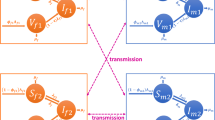Abstract
Human papillomaviruses (HPV) are among the most common sexually transmitted infections and a necessary cause of cervical cancer. In the context of vaccination against a sub-group of genotypes, better understanding the respective role of biological interactions between HPV genotypes and social interactions between humans is essential to anticipate what the vaccine impact could be at the population level. Here, we present a novel stochastic agent-based model formalizing the co-circulation on a human partnership network of multiple interacting genotypes, some of them being preventable by the vaccine (vaccine types) and others not. The model explicitly formalizes heterogeneity in sexual behaviors and allows exploration of distinct genotypic interaction mechanisms during intra-host co-infections. Using model simulations, we investigate infection dynamics after vaccine introduction in the population depending on assumptions about vaccine coverage and interactions between vaccine and non-vaccine genotypes.
A. CM. Thiébaut and L. Opatowski—are equally contributed.
Access this chapter
Tax calculation will be finalised at checkout
Purchases are for personal use only
Similar content being viewed by others
References
Bajos, N., Bozon, M.: Sexualité, genre et santé : les apports de l’enquête Contexte de la sexualité en France. La Découverte (2008)
Auchincloss, A.H., Diez Roux, A.V.: A new tool for epidemiology: the usefulness of dynamic-agent models in understanding place effects on health. Am. J. Epidemiol. 168, 1–8 (2008)
Sanz, J., Xia, C.-Y., Meloni, S., Moreno, Y.: Dynamics of interacting diseases. Phys. Rev. X 4, 041005 (2014)
Bonneault, M., et al.: Contact patterns and HPV-genotype interactions yield heterogeneous HPV-vaccine impacts depending on sexual behaviors: an individual-based model. Epidemics 39, 100584 (2022)
Walboomers, J.M., et al.: Human papillomavirus is a necessary cause of invasive cervical cancer worldwide. J. Pathol. 189, 12–19 (1999)
de Sanjosé, S., et al.: Worldwide prevalence and genotype distribution of cervical human papillomavirus DNA in women with normal cytology: a meta-analysis. Lancet Infect. Dis. 7, 453–459 (2007)
Murall, C.L., McCann, K.S., Bauch, C.T.: Revising ecological assumptions about human papillomavirus interactions and type replacement. J. Theor. Biol. 350, 98–109 (2014)
McLaughlin-Drubin, M.E., Meyers, C.: Evidence for the coexistence of two genital HPV types within the same host cell in vitro. Virology 321, 173–180 (2004)
Choi, Y.H., et al.: 7-valent pneumococcal conjugate vaccination in England and wales: is it still beneficial despite high levels of serotype replacement? PLoS ONE 6, e26190 (2011)
Elbasha, E.H., Dasbach, E.J., Insinga, R.P.: A multi-type HPV transmission model. Bull. Math. Biol. 70, 2126–2176 (2008)
Pons-Salort, M., et al.: Exploring individual HPV coinfections is essential to predict HPV-vaccination impact on genotype distribution: a model-based approach. Vaccine 31, 1238–1245 (2013)
Man, I., Vänskä, S., Lehtinen, M., Bogaards, J.A.: Human papillomavirus genotype replacement: still too early to tell? J. Infect. Dis. 224, 481–491 (2021)
Shiboski, S., Padian, N.S.: Population- and individual-based approaches to the design and analysis of epidemiologic studies of sexually transmitted disease transmission. J. Infect. Dis. 174, S188–S200 (1996)
Olsen, J., Jepsen, M.R.: Human papillomavirus transmission and cost-effectiveness of in-troducing quadrivalent HPV vaccination in Denmark. Int. J. Technol. Assess. Health Care 26, 183–191 (2010)
Van de Velde, N., et al.: Population-level impact of the bivalent, quadrivalent, and nonavalent human papillomavirus vaccines: a model-based analysis. J. Natl. Cancer Inst. 104, 1712–1723 (2012)
Matthijsse, S.M., et al.: The role of acquired immunity in the spread of human papillomavirus (HPV): explorations with a microsimulation model. PLoS ONE 10, e0116618 (2015)
Burger, E.A., Campos, N.G., Sy, S., Regan, C., Kim, J.J.: Health and economic benefits of single-dose HPV vaccination in a Gavi-eligible country. Vaccine 36, 4823–4829 (2018)
Johnson, H.C., et al.: Effect of HPV vaccination and cervical cancer screening in England by ethnicity: a model-ling study. Lancet Public Health. 3, e44–e51 (2018)
ECDC: Guidance on HPV vaccination in EU countries: focus on boys, people living with HIV and 9-valent HPV vaccine introduction. https://www.ecdc.europa.eu/en/publications-data/guidance-hpv-vaccination-eu-focus-boys-people-living-hiv-9vHPV-vaccine. Accessed 02 July 2020
Markowitz, L.E., et al.: Reduction in human papillomavirus (HPV) prevalence among young women following HPV vaccine introduction in the United States, national health and nutrition examination surveys, 2003–2010. J. Infect. Dis. 208, 385–393 (2013)
Trottier, H., et al.: Human papillomavirus infections with multiple types and risk of cervical neoplasia. Cancer Epidemiol. Biomark. Prev. Publ. Am. Assoc. Cancer Res. Cosponsored Am. Soc. Prev. Oncol. 15, 1274–1280 (2006)
Bonneault, M.: Modélisation dynamique des infections et co-infections génitales à papillo-mavirus humain (HPV) et de l’impact à long terme de la vaccination anti-HPV, Université Paris-Saclay, https://theses.hal.science/tel-03231970 (2021)
Bonneault, M., et al.: Ability of epidemiological studies to monitor HPV post-vaccination dynamics: a simulation study. Epidemiol. Infect. 151, e31 (2023)
Mitchell, K.R., et al.: Why do men report more opposite-sex sexual partners than women? analysis of the gender discrepancy in a British national probability survey. J. Sex Res. 56, 1–8 (2019)
Author information
Authors and Affiliations
Corresponding author
Editor information
Editors and Affiliations
Appendix
Appendix
Rights and permissions
Copyright information
© 2024 The Author(s), under exclusive license to Springer Nature Switzerland AG
About this paper
Cite this paper
Bonneault, M., Flauder, M., Delarocque-Astagneau, E., Thiébaut, A.C.M., Opatowski, L. (2024). Human Papillomavirus Co-circulation on a Partially Vaccinated Partnership Network. In: Cherifi, H., Rocha, L.M., Cherifi, C., Donduran, M. (eds) Complex Networks & Their Applications XII. COMPLEX NETWORKS 2023. Studies in Computational Intelligence, vol 1142. Springer, Cham. https://doi.org/10.1007/978-3-031-53499-7_25
Download citation
DOI: https://doi.org/10.1007/978-3-031-53499-7_25
Published:
Publisher Name: Springer, Cham
Print ISBN: 978-3-031-53498-0
Online ISBN: 978-3-031-53499-7
eBook Packages: EngineeringEngineering (R0)




